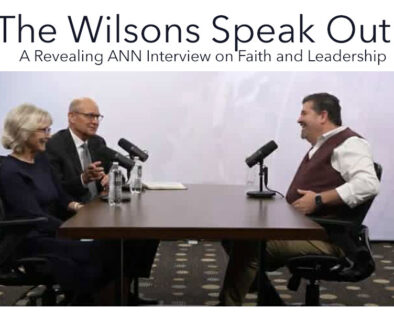Every Congregation Has One—or More
by Lawrence Downing | 22 August 2023 |
Every congregation has at least one: the person who does not quite fit into traditional congregational life.
When author Frederich Buechner was asked to speak at the 200th anniversary of the Rupert, Vermont, Congregational church, he began searching for history about the church. He discovered that in 1831 the congregation had voted to construct a steeple to house a bell. As the dedication ceremony progressed, the congregation’s historian wrote, one Lyman Woodard could be seen making his way up the steeple. When he was at the highest point in the belfry that one could reach, Woodard paused, bent at the waist and, in full view of the startled congregation, stood on his head.
Wrote Buechner,
That’s the one and only thing I’ve been able to find out about Lyman Woodard, whoever he was, but it is enough. I love him for doing what he did. It was a crazy thing to do. It was a risky thing to do. It ran counter to all standards of New England practicality and prudence.
The unusual people
There are always a few people in church who provide the congregation something to talk about during potluck or after a tedious board meeting.
As a child growing up in the San Luis Obispo Seventh-day Adventist church I (and everyone else) was aware, and at times astounded by, the number of people who did not quite fit in.
The man with blue skin caught and held our attention. Someone said that his blueness came as a result of a colloidal silver concoction someone had given him years before to counter a mysterious and long-forgotten health threat. We never knew for sure. But each Sabbath found him among the congregants who met in the church on the corner of Buchon and Osos across from Mitchell Park.
One of the ladies in the church fancied herself a vocalist. When the spirit moved her, she volunteered to share her talent with the congregation. We were treated to her warbling, high-pitch tones, all the while struggling to subdue smirks that threatened to break forth in full-throated guffaws.
My mother learned that a semi-elderly full-bachelor gentleman faithfully followed the Adventist food practice that forbade pork products. To fulfill this mandate, the man poured his pork and beans from the can onto a plate and conscientiously picked out the pork chunks. My mother informed him he could purchase vegetarian beans that would satisfy his dietary custom. This, to Mr. Gray, was new light. He became a fan of Heinz vegetarian beans.
On the platform
The custom in past times mandated that church elders sit on the rostrum, chairs facing the congregation. This arrangement gave the male elders (always men, never women!) a face-on view of the congregation.
Two of the elders, one a physician, the other a sign painter, weekly confronted a foe that defeated their best intentions: neither man could stay awake during the worship service. We kids studied these individuals like a hawk scoping out a mouse, noting when each began to nod, and with eyes closed, succumbed to the angel of sleep. Now and again, with a sudden twitch, one or both would awake.
On at least one occasion one of the men suddenly awakened, rose to his feet, and began to announce the closing hymn. The problem soon became evident: the preacher was still sermonizing. There was a fumbling of words and a weak apology as the elder sat down. We kids were enthralled by these impromptu displays.
The hearing-challenged in the church, sometimes even the elders on the platform, wore klutzy, poorly designed hearing devices. The receiver was about the size of a large cell phone, lodged in a shirt pocket or fastened to the person’s belt, a wire connecting the receiver to the earpiece. A knob located on the top of the receiver controlled the volume, a switch next to the volume control permitted the wearer to turn off the contraption and enjoy silence.
We kids would carefully note, during a laborious sermon, when an elder’s hand would slowly slide toward the receiver, make contact with the OFF switch, and extinguish the sound. In a matter of minutes, the elder, now freed from the preacher’s monotone voice, would nod off into slumberland.
In addition to assisting the wearer to visit slumberland, the device was capable of producing, without warning, a sudden high-pitched squeal. The contribution the offending noisemaker made was to send the wearer into panic. All effort was directed toward squelching the offending instrument.
Until the effort succeeded, the service might well have come to a stop. The audience was captivated by the offending beep. The gyrations of the one who wore the offending instrument provided added amusement.
The aromatic people
2 Corinthians 2:15-17 reads,
For we are to God the pleasing aroma of Christ among those who are being saved and those who are perishing. To the one we are an aroma that brings death; to the other, an aroma that brings life. And who is equal to such a task?
One family took up the saint’s challenge—to provide an aroma. Their method was unusual and successful. The patriarch of the six-member family had a revelation that quantities of onions produced good health: their practice was to consume up to fifty pounds of raw onions per week. The resulting aroma wafted throughout the sanctuary.
The family, seemingly oblivious to the impact their new-found health practice had on the congregation, were faithful in their church attendance. The congregants responded as one might expect: it was not long before the Onion Family found themselves a planted center point surrounded by pews void of fellow parishioners who sought refuge from an aroma quite unlike that which the apostle envisioned.
Hunting—for what?
Tom was a member of a small Adventist congregation. He had been married several times and was currently married to a quiet woman who always looked a bit weary. She and her young daughter dressed in what could be classified as Dorcas cast-offs. What people noted, other than the poor quality of their apparel, was that Tom was consistent in his church attendance and brought his family along with him. They filled one of the wooden pews.
Tom was always quick to exhort others in the congregation to practice integrity and avoid temptation. He would expound on other people’s evils, and parrot pieties chastising those who countered his understanding of the Christian life. People were impressed by his piety and his promotion of good behavior.
Then, suddenly, Tom disappeared, to be heard of no more. It was discovered that his exit had been encouraged by the discovery of a unique behavior.
Tom, it turned out, had an obsession with women’s undergarments. He worked for a company whose product was home-delivered, and on occasions, the product was placed in the house itself. Tom’s manager learned that Tom, when he made his deliveries when no one was home, would rummage through the woman’s dresser and confiscate items that stimulated his fantasy. This was the end of his job, and of his pious chastisement of others in church.
Another church member, Joe, hunted and shot big game, the largest creatures on planet Earth. Now, hunting wasn’t unusual for people who lived in rural areas. What was an uncommon twist to the sport was his method: he flew a single-engine high-wing aircraft propelled by a reverse-positioned engine bolted to the top of the aircraft. A small-bore cannon, attached to the dashboard, could fire a round from the front of the craft without threat to the rear-positioned propeller.
Joe flew along the California coast in search of a pod of whales. When he spouted the characteristic spout or the large tail he would circle round the pod until he had a sure view of one whale. He would sight the gun to intersect the unsuspecting leviathan, fire the cannon, and wait to see if his shot had been successful. If the whale was fatally wounded, he would drop a flag on the whale’s back, find a spot to land his craft, make his way to the beach closest to where he had shot the whale, and look to find where the carcass had floated ashore.
When he located the whale, he put on water-proof boots, collected his knives and other carving instruments, and began cutting the whale to retrieve the large liver that made up a significant portion of the now-dead creature. The liver was his pot of gold, apparently prized by drug makers for creating various health products and other commercial uses.
With the children
My mother was a long-time leader of a children’s division of Sabbath School. She cut out felt figures that represented Bible characters. Someone would select an interesting Bible story, such as Daniel in the lions’ den. During the story, the tension between the big cats and the young Daniel would be accompanied by the placement of the felt figures representing the various components described in the story. The children were enthralled.
Then one day, during a class session, one of the children mewed like a cat. This sound was repeated. None of the adults paid attention. After one especially enthusiastic feline meow, a stream of liquid dripped off the chair and puddled round the feet of the meower. Her mother was fetched, who informed the Sabbath School staff that the meow was a code between the child and mother that the girl needed to heed the call of nature. Of course, the teachers didn’t know this; thus the unfortunate accident.
The brother of the meow girl possessed an unusual handicap. At times, standing with the other children during a special presentation by the children at church, he would without warning tilt to one side. Knowing this would happen, his mother or another near-by adult would reach out to catch him and very simply return him to an upright position—almost without a second thought—and the program would continue.
We kids were fascinated by these spells, and impressed with the adults’ ability to rescue and restore what might have otherwise meant the boy’s head coming in contact with a wooden floor. In the course of time, others of us had the opportunity to rescue our classmate when he showed signs that he was about to tilt: we would bring him back to the vertical position and sometimes guide him to a chair.
Every congregation has some
People with behaviors that are counter to the expected norm are found in every congregation. Every congregation contains people with quirks and unusual behaviors. The wonder, the miracle, the glory is that others welcome such individuals and consider them as much a part of God’s family as any other person. The odd people are part of the irony and contradiction of God’s kingdom.
Frederich Buechner writes of the headstanding Lyman Woodard (and all of the other glorious misfits in churches):
[Woodard] stood the whole idea that you’re supposed to be nothing but solemn in church on its head just like Lyman himself standing upside down on his. And it was also a magical and magnificent and Mozartian thing to do. If the Lord is indeed our shepherd, then everything goes topsy-turvy. Losing becomes finding and crying becomes laughing. The last become first and the weak become strong. Instead of life being done in by death in the end as we always supposed, death is done in finally by life in the end. If the Lord is our host at the great feast, then the sky is the limit.
 Lawrence Downing, D.Min, is a retired pastor who has served as an adjunct instructor at La Sierra University School of Business and the School of Religion, and the Adventist International Institute of Advanced Studies in the Philippines.
Lawrence Downing, D.Min, is a retired pastor who has served as an adjunct instructor at La Sierra University School of Business and the School of Religion, and the Adventist International Institute of Advanced Studies in the Philippines.




